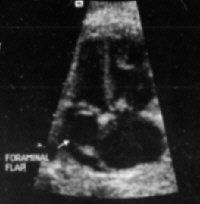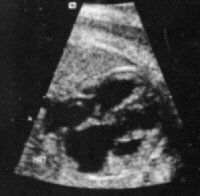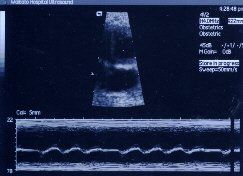Redundant Septum Primum Flap in Fetus with Premature Atrial Contractions
The mobile foraminal flap consisted of a thin membrane ballooning into the left atrium. During ventricular filling, the flap encroached on the mitral valve annulus, but did not appear to obstruct the mitral valve flow.



The mobile foraminal flap consisted of a thin membrane ballooning into the left atrium. During ventricular filling, the flap encroached on the mitral valve annulus, but did not appear to obstruct the mitral valve flow. Greyscale appearances were indicative of redundant septum primum flap (RSPF). Doppler traces obtained at the mitral valve showed normal flow patterns without evidence of stenosis. M-mode sonography taken simultaneously through the atria and ventricles demonstrated persistent supraventricular arrhythmia consistent with PACs some of which were non-conducted (Figure 2).


Discussion: The thin membranous septum primum divides the fetal atria early in embryonic development. The thicker septum secundum grows along the septum primum, and contains an opening referred to as the foramen ovale. Sonographic appearance of the septum primum and secundum have been well documented and are reproducible in many patients. The foramen ovale allows normal right-to-left atrial shunting during fetal life. Flow across the foramen ovale displaces the septum primum into the left atrium. The septum primum is relatively pocket-shaped and is not intact along the entire extent of the inter-atrial septal wall, allowing blood to pass from right to left atrium. However, because the opening of the septum primum is not directly over with the foramen ovale, the septum primum will effectively close the foramen ovale in early neonatal life as left atrial pressure exceeds right atrial pressure and the septum primum adheres to the septum secundum.1
Redundant septum primum flap, also known as Foramen Ovale Aneurysm, Atrial Septal Aneurysm (ASA), or Aneurysm of Septum Primum has been reported in 0.6-1.7% of fetuses referred for echocardiographic examination.2,3 The prevalence of RSPF in the general population is unknown. This is due to the fact that RSPF may be easily overlooked on gross cardiac evaluation and routine fetal echocardiography would be required in order to establish the true incidence.3,4 The origin of RSPF is under debate. RSPF has been considered as a congenital variant perhaps due to weaker septum primum tissue.2 Observations in the neonatal group however suggest that at least some redundancies may be acquired. This hypothesis was based on the fact that atrial septal aneurysms tend to get worse in patients with abnormal atrial hemodynamics, but tend to resolve in patients with normal hemodynamics.3
A strong association exists between the presence of RSPF and PACs.2,5 The mechanism is not entirely clear. Possible explanations may include: 1) the base of the foraminal flap may cause mechanical irritation to the sino-atrial node, 2) or it may be the interaction between the foraminal flap and the left atrial wall, or 3) the ASA may may cause blocking of SA-AV node transmission. Whatever the precise cause, PACs tend to resolve spontaneously in neonatal life when the foraminal flap adheres to the septum secundum and no longer protrudes into the left atrium.4,6
In summary, RSPF is occasionally noted on obstetric ultrasound. When the gross cardiac anatomy appears otherwise normal, RSPF most likely represents a benign variant. PACs are frequently associated with RSPF, but tend to resolve neonatally with the involution of the RSPF.
References:
Citation: Necas M: "Redundant Septum Primum Flap in Fetus with Premature Atrial Contractions"; April 2000
References:
1. Kachalia P, Bowie JD, Adams DM, Caroll BA: In Utero Sonographic Appearance of the Atrial Septum Primum and Septum Secundum. J Ultrasoudn Med 1991;10:423-6.
2. Stewart PA, Wladimiroff JW: Fetal Atrial Arrhythmias Associated with Redundancy/Aneurysm of the Foramen Ovale. J Clin Ultrasound 1988; 16:643-50.
3. Wolf WJ, Casta A, Sapire D: Atrial Septal Aneurysms in Infants and Children. Am Heart J 1987; 113:1149-1153.
4. Pinette MG, Pan Y, Pinette SG, et al: Fetal Atrial Septal Aneurysm. JRM 1997; 42: 459-462.
5. Rice MJ, McDonald RW, Reller MD: Fetal Atrial Septal Aneurysm: A Cause of Fetal Atrial Arrhythmias. J Am Coll Cardiol 1988; 12:1292-7.
6. Toro L, Weintraub G, Shiota T, et al: Relation Between Persistant Atrial Arrhythmias aand Redundant Septum Primum Flap (Atrial Septal Aneuyrsm) in Fetuses. Am J Cardiol 1994: 73:711-3.
S1E4: Dr. Kristina Adams-Waldorf: Pandemics, pathogens and perseverance
July 16th 2020This episode of Pap Talk by Contemporary OB/GYN features an interview with Dr. Kristina Adams-Waldorf, Professor in the Department of Obstetrics and Gynecology and Adjunct Professor in Global Health at the University of Washington (UW) School of Medicine in Seattle.
Listen
Study shows a healthy prenatal diet could be upstream obesity prevention strategy
December 26th 2024"Our findings support the recommendation of a healthy diet based on the current guidelines (as measured by the HEI) during pregnancy, since it may reduce patterns of infant growth outside reference ranges."
Read More
Early pregnancy cannabis use high in states with recreational legalization
November 11th 2024A population-based time-series analysis California before, during and after legalization show a rising trend in women using cannabis while pregnancy especially when the state has legalized the drug.
Read More
